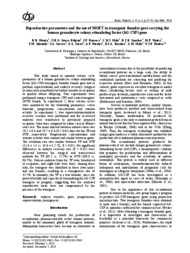Reproductive parameters and the use of MOET in transgenic founder goat carrying the human granulocyte colony-stimulating factor (hG-CSF) gene.
Reproductive parameters and the use of MOET in transgenic founder goat carrying the human granulocyte colony-stimulating factor (hG-CSF) gene.
Autoria: MOURA, R. R.; SOUZA-FABJAN, J. M. G.; FONSECA, J. F. da; MELO, C. H. S.; SANCHEZ, D. J. D.; VIEIRA, M. P.; ALMEIDA, T. M.; SEROVA, I. A.; SEROV, O. L.; PEREIRA, A. F.; TEIXEIRA, D. I. A.; MELO, L. M.; FREITAS, V. J. F.
Resumo: Abstract: This study aimed to monitor estrous cycle parameters of a human granulocyte colony-stimulating factor (hG-CSF)-transgenic founder female goat and to perform superovulation and embryo recovery (surgical or transcervical method) for further transfer to recipients to quickly obtain offspring. Two experiments were performed using a transgenic (TF) and a non-transgenic (NTF) female. In experiment 1, three estrous cycles were monitored for the following parameters: estrus behavior, progesterone concentration and ovarian activity. In experiment 2, two superovulation/embryo recovery sessions were performed and the recovered embryos were transferred to previously prepared recipients. Data were compared by either t test or Fisher's exact test. The mean interval between natural estrus was 20.7 ± 0.6 and 19.7 ± 0.6 (P > 0.05) days for the TF and NTF, respectively. Progesterone concentrations and ovarian activity were normal and similar between goats. The ovulation rate was similar between TF and NTF (12.0 ± 1.4 vs. 18.0 ± 4.2 CL; P > 0.05). No significant differences in embryo recovery rate (P > 0.05) were observed between the surgical and transcervical methods for TF (69.2 vs. 72.7%) or NTF (100.0 vs. 86.7%). Sixteen embryos from the TF were transferred to recipients, and eight kids were born. Among these kids, the transgene was identified in three (two males and one female), resulting in a transgenesis rate of 37.5%. In summary, the TF is a true founder, since she proved fertility and capacity of transmitting the hG-CSF transgene to progeny, suggesting that the analyzed reproductive traits were not compromised by the presence of the transgene.
Ano de publicação: 2014
Tipo de publicação: Artigo de periódico
Unidade: Embrapa Caprinos e Ovinos
Palavras-chave: Cabra, Caprino, Goat, Hormônio animal, Progesterona, Superovulação, Transferência de embrião, Transgenia
Observações
1 - Por padrão são exibidas publicações dos últimos 20 anos. Para encontrar publicações mais antigas, configure o filtro ano de publicação, colocando o ano a partir do qual você deseja encontrar publicações. O filtro está na coluna da esquerda na busca acima.
2 - Para ler algumas publicações da Embrapa (apenas as que estão em formato ePub), é necessário ter, no celular ou computador, um desses softwares gratuitos. Sistemas Android: Google Play Livros; IOS: iBooks; Windows e Linux: software Calibre.
Acesse outras publicações
Acesse a Base de Dados da Pesquisa Agropecuária (BDPA) para consultar o acervo completo das bibliotecas da Embrapa.

